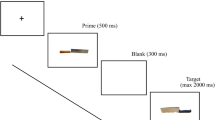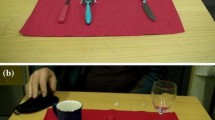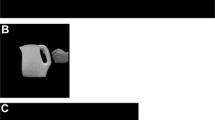Abstract
Previous studies have shown that observation of object automatically elicits the activation of a reach-to-grasp response specifically directed to interact with the object, which is termed affordance. Recent findings provide evidences that even dangerous objects can evoke aversive affordances. However, these studies only focused on avoidance effect emerged with dangerous objects. It remains unclear whether the neutral object and dangerous object share a common mechanism for the processing of affordance information. The affordance effect is considered to be a type of conflict between the afforded response and the response required by the task. In a symbol judgment task, we simultaneously presented the neutral object and dangerous object to investigate whether the congruency sequence effects (congruency effects following incongruent trials are smaller than those following congruent trials) occurred across the two types of affordance conflict, which is typically assumed that such flexible adjustments can only be observed between the same conflict types. It was found that congruency sequence effects were only generated between the same types of affordance conflict (e.g., neutral object or dangerous object), but not between two different affordance conflict types (e.g., neutral object and dangerous object). These results indicate there may be two different pathways for the processing of affordance of the neutral and dangerous object.



Similar content being viewed by others
References
Akçay, Ç., & Hazeltine, E. (2011). Domain-specific conflict adaptation without feature repetitions. Psychonomic Bulletin & Review, 18, 505–551.
Anelli, F., Borghi, A. M., & Nicoletti, R. (2012). Grasping the pain: motor resonance with dangerous affordances. Consciousness and Cognition, 21, 1627–1639.
Anelli, F., Nicoletti, R., Bolzani, R., & Borghi, A. M. (2013). Keep away from danger: dangerous objects in dynamic and static situations. Frontiers in Human Neuroscience, 7, 344. doi:10.3389/fnhum.2013.00344.
Coello, Y., Bourgeois, J., & Iachini, T. (2012). Embodied perception of reachable space: how do we manage threatening objects? Cognitive Processing, 13, 131–135.
Couth, S., Gowen, E., & Poliakoff, E. (2014). Dissociating affordance and spatial compatibility effects using a pantomimed reaching action. Experimental Brain Research, 232, 855–864.
Di Pellegrino, G., Fadiga, L., Fogassi, L., Gallese, V., & Rizzolatti, G. (1992). Understanding motor events: a neurophysiological study. Experimental Brain Research, 91, 176–180.
Egner, T. (2008). Multiple conflict-driven control mechanisms in the human brain. Trends in Cognitive Sciences, 12, 374–380.
Egner, T., Delano, M., & Hirsch, J. (2007). Separate conflict-specific cognitive control mechanisms in the human brain. NeuroImage, 35, 940–948.
Ellis, R., & Tucker, M. (2000). Micro-affordance: the potentiation of components of action by seen objects. British Journal of Psychology, 91, 451–471.
Funes, M. J., Lupiáñez, J., & Humphreys, G. (2010a). Analyzing the generality of conflict adaptation effects. Journal of Experimental Psychology: Human Perception and Performance, 36, 147–161.
Funes, M. J., Lupiáñez, J., & Humphreys, G. (2010b). Sustained versus transient cognitive control: evidence of a behavioral dissociation. Cognition, 114, 338–347.
Gibson, J. J. (1979). The ecological approach to visual perception. Boston: Houghton Mifflin.
Liu, D., Wang, Y., & Zhou, X. (2011). Lexical-and perceptual-based object effects in the two-rectangle cueing paradigm. Acta Psychologica, 138, 397–404.
McBride, J., Sumner, P., & Husain, M. (2012). Conflict in object affordance revealed by grip force. The Quarterly Journal of Experimental Psychology, 65, 13–24.
Murata, A., Gallese, V., Luppino, G., Kaseda, M., & Sakata, H. (2000). Selectivity for the shape, size, and orientation of objects for grasping in neurons of monkey parietal area AIP. Journal of Neurophysiology, 83, 2580–2601.
Murphy, S., van Velzen, J., & de Fockert, J. W. (2012). The role of perceptual load in action affordance by ignored objects. Psychonomic Bulletin & Review, 19, 1122–1127.
Phillips, J. C., & Ward, R. (2002). SR correspondence effects of irrelevant visual affordance: time course and specificity of response activation. Visual Cognition, 9, 540–558.
Rizzolatti, G., Fadiga, L., Fogassi, L., & Gallese, V. (1996). Premotor cortex and the recognition of motor actions. Cognitive Brain Research, 3, 131–141.
Symes, E., Ellis, R., & Tucker, M. (2005). Dissociating object-based and space-based affordances. Visual Cognition, 12, 1337–1361.
Symes, E., Ellis, R., & Tucker, M. (2007). Visual object affordances: object orientation. Acta Psychologica, 124, 238–255.
Tucker, M., & Ellis, R. (1998). On the relations between seen objects and components of potential actions. Journal of Experimental Psychology: Human Perception and Performance, 24, 830–846.
Tucker, M., & Ellis, R. (2001). Micro-affordance of grasp type in a visual categorisation task. Visual Cognition, 8, 769–800.
Vainio, L., Ellis, R., & Tucker, M. (2007). The role of visuospatial attention in action priming. Quarterly Journal of Experimental Psychology, 60, 241–261.
Zhao, J., Wang, Y., Liu, D., Zhao, L., & Liu, P. (2015a). Strength of object representation: its key role in object-based attention for determining the competition result between gestalt and top-down objects. Attention, Perception, & Psychophysics, 77, 2284–2292.
Zhao, L., Bai, Y., Ma, J., & Wang, Y. (2015b). Local control mechanisms of implicit and explicit conflicts. Experimental Psychology, 62, 153–160.
Acknowledgments
This study was supported by a grant from Programs of Scientific Research Foundation for Doctor (ZK16037) of Baoji University of Arts and Sciences to Liang Zhao.
Author information
Authors and Affiliations
Corresponding author
Ethics declarations
Conflict of Interest
We declare that we have no conflict of interest.
Ethical Approval
All procedures performed in studies involving human participants were in accordance with the ethical standards of the institutional research committee and with the 1964 Helsinki declaration and its later amendments or comparable ethical standards.
Informed Consent
Informed consent was obtained from all individual participants included in the study.
Rights and permissions
About this article
Cite this article
Zhao, L. Separate Pathways for the Processing of Affordance of Neutral and Dangerous Object. Curr Psychol 36, 833–839 (2017). https://doi.org/10.1007/s12144-016-9472-9
Published:
Issue Date:
DOI: https://doi.org/10.1007/s12144-016-9472-9




